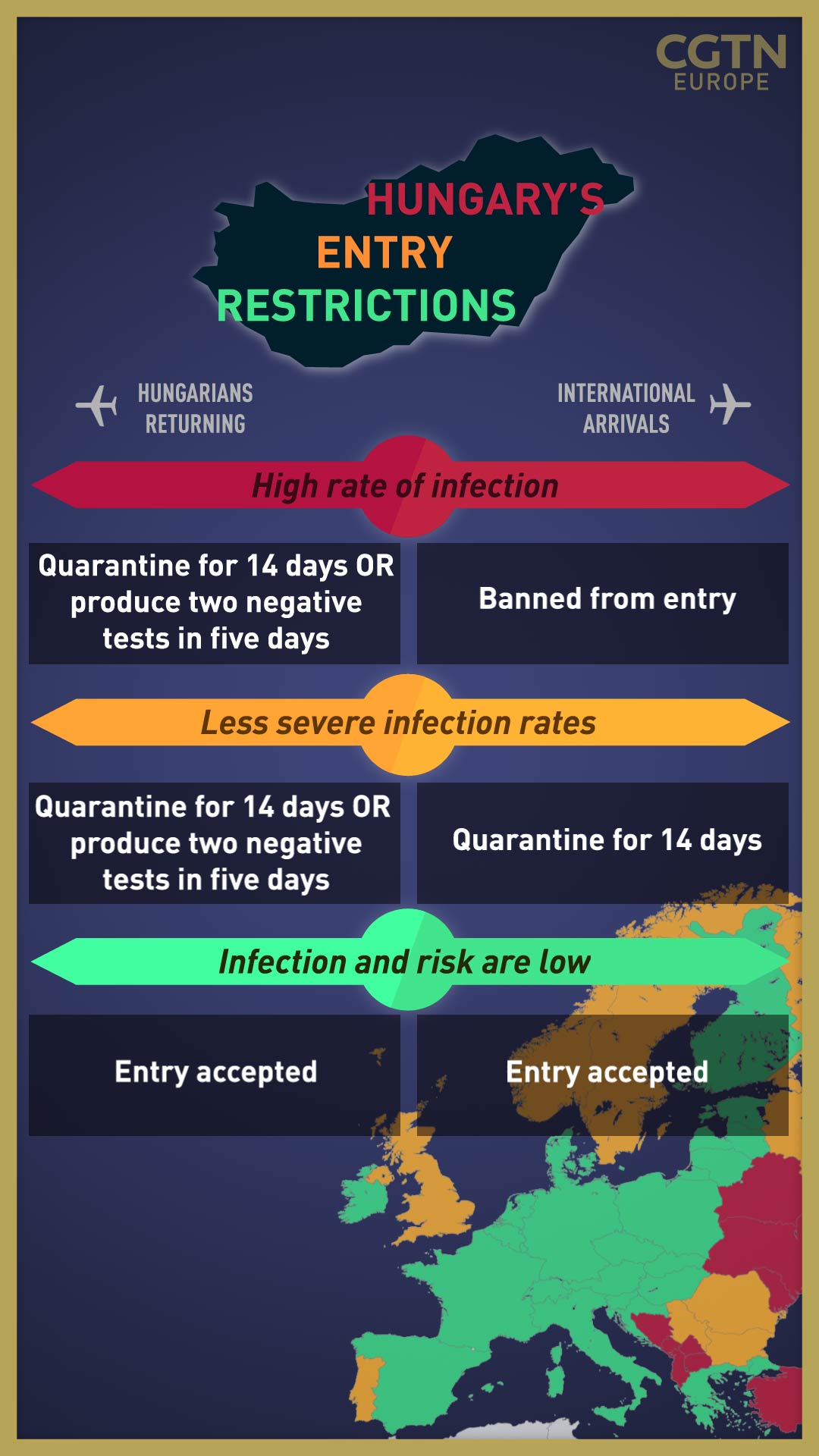00:55

Hungary introduced tough new rules on Wednesday for both Hungarian citizens and foreign nationals entering the country in a bid to prevent a second wave of COVID-19.
Each country in the world has been assigned either red, yellow or green status according to its current level of COVID-19 infection and those colors dictate whether an entry ban or mandatory quarantine is imposed.
Red means foreign nationals from that country won't be allowed to enter. All of Asia is red, except Japan and China, and the Americas are all red, except the U.S.. All countries in Africa as well as Australia and New Zealand are also red. Hungarian citizens from red nations can enter if they quarantine for 14 days or produce two negative tests.
Yellow indicates that Hungarian citizens or foreigners from these countries can enter the country if they produce a negative test or complete a 14-day quarantine.
Green means people can enter the country freely and most countries within the European Union (EU) have been assigned this status, though randomized tests will be made on green arrivals.

Hungary has introduced a traffic light system for Hungarian citizens and foreign nationals entering the country to limit the risk of importing cases of COVID-19. /AP
Hungary has introduced a traffic light system for Hungarian citizens and foreign nationals entering the country to limit the risk of importing cases of COVID-19. /AP
If we don't put these restrictions in place and someone happens to carry the virus back to Hungarian territory, then we'd have to shut down the economy and restore lockdown measures again
- Hungary's Foreign Minister, Peter Szijjarto
The government says Hungary is among the safest countries in Europe, thanks to Hungarians obeying lockdown measures over the past few months.
But over recent weeks, infection rates have spiked in neighboring countries.
Hungary has just over 540 active cases, according to government figures, while Ukraine has more than 26,000, Romania and Poland just under 10,000 and Serbia 4,500.
Read more: Budapest's 'street lawyers' see surging demand in service after COVID-19 lockdown
This prompted Hungary to introduce a colour code system, a measure authorities say will stop the virus being imported.
Foreign Minister Peter Szijjarto said: "If we don't put these restrictions in place and someone happens to carry the virus back to Hungarian territory, then we'd have to shut down the economy and restore lockdown measures again. We don't want any of this at all."

A worker disinfects the baggage container of a plane of the Hungarian low-cost airline Wizz Air in Budapest./AP
A worker disinfects the baggage container of a plane of the Hungarian low-cost airline Wizz Air in Budapest./AP
Health policy expert Balazs Rekassy says it's a good idea but poorly implemented and the way countries have been categorized is illogical.
"Cases in the U.S. are still rising and there are a very high number of incidents, so it's a surprise to me this is just categorized as the middle category," Rekassy said.
"Also, we can take the example of Croatia, Croatia is very important from an economic standpoint, and a neighboring country with Hungary, where lots of Hungarians travel to take their vacations and the two countries have relatively good political connections. Croatia is categorized as green, despite the fact the cases are heavily rising in Croatia as well."
Read more: Countries around the world battle a surge in COVID-19 cases
But Szijjarto insists the restrictions are not political. "We consider various aspects of national security, healthcare risk factors and virology when we assign color codes to different countries," he said. "This has nothing to do with diplomatic relations and foreign policy."
Meanwhile, It remains mandatory to wear a mask at supermarkets and on public transport in Hungary, but the government says it has no plans yet to reintroduce any further anti-infection measures.
The border entry restrictions will be reviewed weekly.